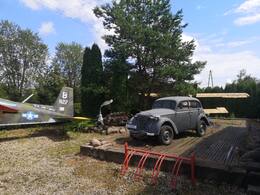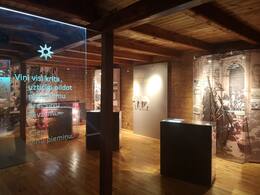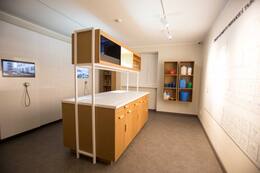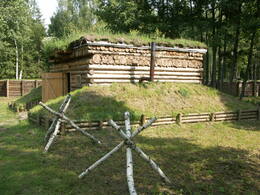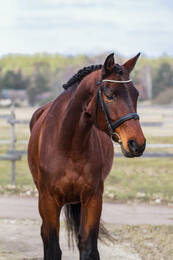Pirmojo pasaulinio karo ir Kalėdų mūšių įrodymai Rygos regione
Diena 1.
180 km
Rīga – Ciemupe – Ogre – Tīnūži – Ikšķile – Olaine – Ložmetējkalns – Tīreļpurvs
Praktinė informacija
- Driving distance: 180 km
- Due to distances and time, 4 of the listed sights can be visited on this day
- Museum in “Tīnūži Manor” is open only on working days
- Visiting the “Tīreļi Distillery” by advance booking
- Opening hours of the Olaine History and Art Museum Museum and the dugout reconstruction should be checked in advance. The World War I Historical Exploration Route is open 24/7
- The indoor exposition of the Christmas Battles museum is open from Wednesday till Sunday. Outdoor exhibitions are open 24/7
Lankytinos vietos
Kavinė „Dakota“ ir karinės technikos bei įrangos ekspozicija
Kavinė „Dakota“ yra įsikūrusi Ogrės savivaldybėje, Ciemupėje, prie A6 greitkelio. Karinio paveldo ekspozicija leidžia jos savininkui suderinti savo pomėgį ir susidomėjimą karine istorija su kavinės verslu. Čia galite pasimėgauti maistu ir pamatyti XX a. pabaigos karinę techniką, ginklus, kareivių įrangą ir lėktuvus. Ekskursijos kavinės lankytojams prieinamos darbo valandomis. Ekskursijos vyksta tik rusų kalba, būtina išankstinė registracija.
Kultūros paveldo centras „Tīnūžų dvaras“
Kultūros paveldo centras „Tīnūžių dvaras“ yra Ogrės savivaldybėje, Tīnūžių kaime, 7 km nuo Ogrės ir Ikškilės miestų. Pirmieji rašytiniai duomenys apie dvarą siekia XVI a. Iki XVIII a. vidurio jis buvo laikomas ekonominiu gamybos vienetu su mažais ir nereikšmingais pastatais. Tačiau laikui bėgant jis išaugo į didelį ūkį. Pirmojo pasaulinio karo metu čia vyko Rusijos ir Vokietijos armijų mūšiai, kuriuose dalyvavo ir Latvijos šauliai. Nepriklausomybės karo metu Tīnūžių dvaras buvo naudojamas kaip Latvijos armijos 1-ojo Valmieros pėstininkų pulko štabas ir šarvuočių aikštelė. 1932 m. dvaras buvo perduotas Latvijos karo invalidų sąjungai, kuri apgyvendino ir rūpinosi karo veteranais. Antrojo pasaulinio karo metu (1943 m.) iš Estijos į Tīnūžių dvarą buvo perkeltas Vokietijos armijos dalinys FAT 212. Tai buvo diversantų dalinys, rengęs karius kovai su Raudonąja armija. Latvijos kareiviai taip pat buvo apmokyti žvalgybos rinkimo, partizaninio karo taktikos ir sabotažo menų. Tīnūžių dvaro pono rūmai buvo sugriauti, kai Raudonoji armija judėjo Rygos link. Šiandien tai vieta su nuostabiu kraštovaizdžiu ir istoriniais pastatais Mažosios Juglos upės pakrantėje. Kultūros paveldo centre „Tīnūžių dvaras“ galima pamatyti ekspozicijas, skirtas istoriniams įvykiams, įskaitant ir tas, kurios susijusios su Latvijos šauliais.
Olaine istorijos ir meno muziejus
Olainės istorijos ir meno muziejaus ekspozicija pasakoja apie sovietinės okupacijos laikotarpį Olainėje. Muziejaus teritorijoje sukurtas Pirmojo pasaulinio karo žvalgybinis maršrutas su restauruotais įtvirtinimų elementais. Vietoje, kur anksčiau buvo Pirmojo pasaulinio karo Rusijos armijos gynybos linija, pastatytas rusų kareivio tipo apkasas, o lankytojai gali apžiūrėti šaudymo bokšto fragmentą. Jaunolainėje, sankryžoje su Plakanciemu, galima pamatyti Pirmojo pasaulinio karo gelžbetoninį įtvirtinimą. Pirmojo pasaulinio karo metu šioje vietovėje vyko aktyvūs mūšiai tarp Rusijos ir Vokietijos armijų. Latvijos šaulių daliniai dalyvavo žvalgyboje ir įvairiose kitose operacijose. Pelkėtos žemės apsunkino gynybą, tačiau tai buvo labai svarbi teritorija Latvijos karinėje istorijoje. Olainė susiformavo dėl patogios vietos tarp Jelgavos ir Rygos, kur šiuo metu yra Jaunolainė. Netoliese buvo Olainės dvaras. Dabartinė Olainė buvo pastatyta sovietinės okupacijos metu, kai čia pradėjo veikti pramonės įmonės.
Kalėdų mūšių muziejus
Muziejus, įsikūręs sodyboje „Mangaļi“ Jelgavos apylinkėse, Valgundės seniūnijoje, yra Latvijos karo muziejaus filialas. Jis atidarytas 2005 m. toje vietoje, kurioje per Pirmąjį pa saulinį karą vyko Kalėdų mūšiai. Šiose vietose iki šiol tebėra išlikę išskirtiniai Pirmojo pasaulinio karo įtvirtinimai. Kalėdų mūšių muziejaus ekspozicija yra įrengta autentiškoje vieto je po atviru dangumi. Čia galima pamatyti rekonstruotą įtvirtinimų sistemos fragmentą – lauko slėptuvę ir dalį pir mosios vokiečių gynybos linijos, vadinamos „vokiečių pyli mu“. Tai vienintelis tokio pobūdžio objektas Baltijos šalyse. Kalėdų mūšiai – vienas žinomiausių ir dramatiškiausių Pir mojo pasaulinio karo įvykių Latvijoje. Jie užima ypatingą vietą latvių karo ir kultūros istorijoje. Intensyvūs mūšiai truko šešias dienos ir pareikalavo daug aukų. Šie įvykiai dažniau siai siejami su latvių šaulių puolimu prieš Vokietijos kariuo menę, vykusiu ypač atšiauriomis ir nepalankiomis žiemos sąlygomis. Tai buvo pirmas kartas, kai didelio masto puo limas vyko be artilerijos palaikymo. Šiuo metu muziejuje eksponuojami mūšių vietose rasti radi niai. Vidaus ekspozicija lankoma nustatytu laiku, o po atvi ru dangumi esančių įtvirtinimų ekspoziciją galima apžiūrėti kiekvieną dieną. Apylinkėse sudaryti turistiniai maršrutai ir įrengti pažintiniai takai.
Tīreļi Distillery, horse riding with type of horses used in World War I
Tīreļi Distillery is a small, private farm and strong alcoholic drink brewery near the Christmas Battle Museum and Tīreļi swamp at the Kalnciems bridge over Lielupe. It also offers horseback rides to places significant to World War I. Horseback rides take place on the route Jaunmārupe-Tīreļi and Tīreļi-Jaunbērze. During this ride you'll get the chance to see the surroundings, memorial sites, trenches, Ložmetējkalns and other historical places. Horses are of the same breed that was used during World War I. You can also take a tour of the brewery and see the farm animals. Places for rest, picnics and camping are also available.
Vietos pavalgyti
Dakota Cafe in Ciemupe
The “Aitiņlauvas” saloon
The saloon is on the edge of the Rīga-Liepāja highway (A9) at the 22 km road marker. Most of the dishes are based on ingredients from the forest. The interior design is based on hunting, and there is a paddock of wild deer alongside the restaurant.
Latvian cuisine: Roast buck, roast wild boar, venison steak, roast lamb, stuffed river trout.
Bakery and tavern LĀČI
Lāči brand bread is popular in Latvia and abroad, because the bakery uses ancient mastery and skills. Baking traditions are supervised by 2 master bakers and 4 journeymen. You can take a tour of the bakery, knead and bake your own little loaf of bread, have lunch at a cosy saloon and purchase the bakery’s products. Lāči uses its own ingredients for its dishes, combining them with seasonal products from local farms. The bakery shop offers a wide range of products from bread to confectionery.
Latvian cuisine: Cream of mushroom soup, various hot potted dishes, bread soup, baker’s dessert.
The “Eglieni” saloon
The saloon is on the edge of the Rīga-Liepāja highway (A9) at the Eglieni leisure complex, which merges the Latvian environment with the modern environment. Herbs come from the complex’s own garden.
Latvian cuisine: Cold beet soup, herring with cottage cheese and soured cream, grit sausage with cottage cheese balls, stacked rye bread, cottage cheese dessert with compote, country teas, kvass.
Special foods: Mushroom soup and filet of chicken stuffed with mushrooms.
Vietos apsistoti
PILSĒTNIEKI
Guest-house for vacationers and celebrants. 7 well equipped bedrooms, room for seminars, tent and trailer sites. Fishing and swimming in the pond. Sauna.
The Šlokenbeka Estate
The estate in Milzkalne that is along the banks of the Slocene River dates back to the 15th century, when it was built as a closed complex for the Livonian Order. It is the only fortified estate of its type to have survived to the present day, and it was once used as a hiding place for aristocrats during an attack. The gate towers with their ornate weather vanes were built in the late 17th century, and the ancillary buildings date back to the 18th and 19th century. A brick wall with firing apertures survives. The Latvian Road Museum is in one of the wings of the complex, while the former mansion offers accommodations, tours and tastings of local goodies.




